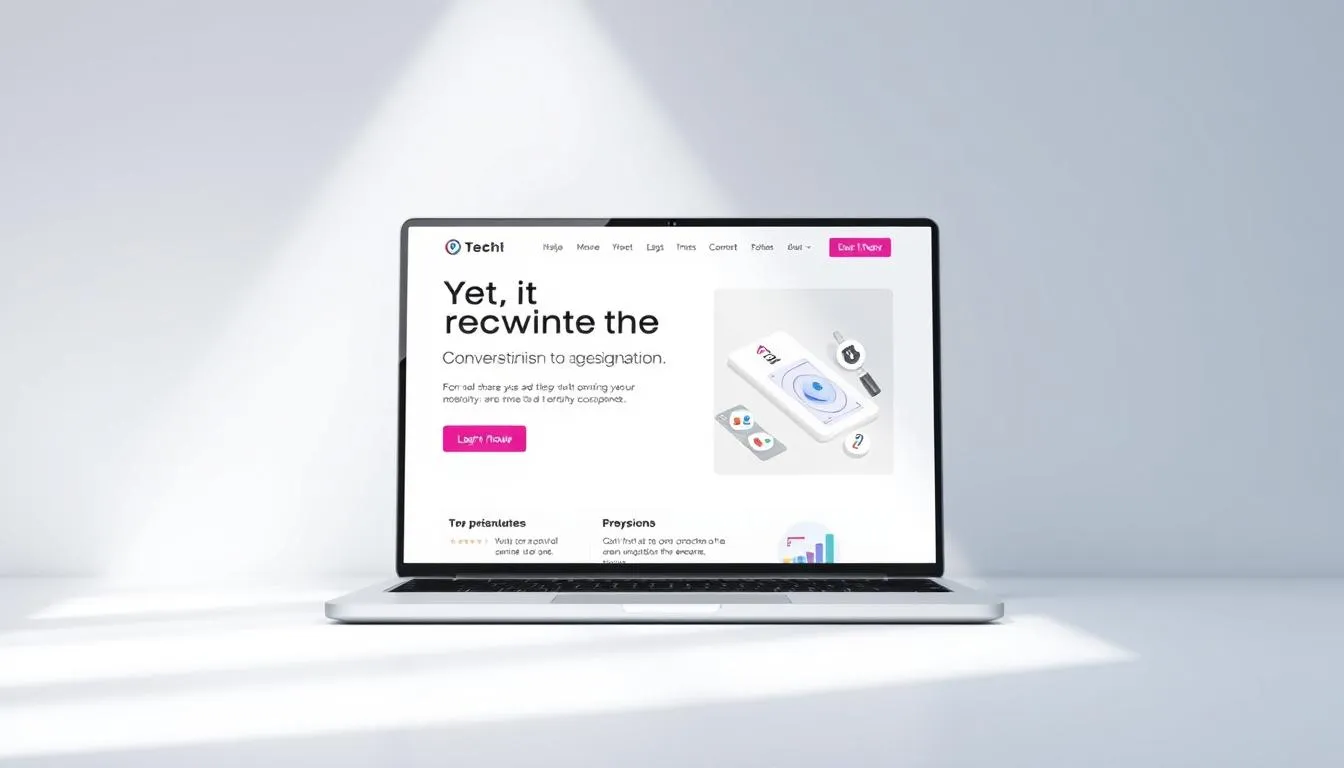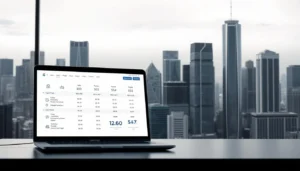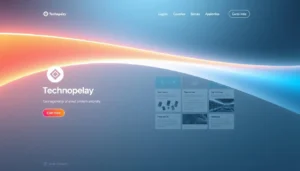Last Updated on: June 19, 2025
Creating a tech website design that drives results requires a deep understanding of your target audience and the tech industry’s best practices.
A well-designed website is crucial for conversion optimization, enabling you to achieve your business goals.
By incorporating tech industry best practices, you can create a website that not only looks great but also resonates with your audience.
Key Takeaways
- Understand your target audience’s needs and preferences.
- Incorporate tech industry best practices into your website design.
- Optimize your website for conversions.
- Use a clear and concise messaging framework.
- Ensure a seamless user experience.
Understanding Your Tech Audience and Their Needs
To create a tech company website that truly resonates, you must first understand your audience. Understanding your tech audience is crucial for designing a website that meets their needs and guides them through the sales funnel.
Identifying Your Ideal Tech Customer Persona
Identifying your ideal customer persona involves understanding their pain points, preferences, and behaviors. This process helps in tailoring your website’s content and design to appeal to your target audience effectively.
B2B vs. B2C Tech Audience Differences
The tech audience can be broadly categorized into B2B (Business-to-Business) and B2C (Business-to-Consumer) segments. B2B audiences typically look for detailed product information, ROI analysis, and support for complex decision-making processes. In contrast, B2C audiences are more focused on user experience, product benefits, and straightforward purchasing processes.
Decision-Maker Profiles in Tech Purchases
Understanding the profiles of decision-makers in tech purchases is vital. These individuals often have specific technical expertise and are influenced by factors such as product reliability, scalability, and vendor reputation.
Analyzing Competitor Websites in the Tech Space
Analyzing competitor websites provides valuable insights into industry best practices and areas for differentiation. By examining how competitors structure their websites, you can identify opportunities to improve your own site’s user experience and conversion rates.
Mapping the Customer Journey for Tech Products/Services
Mapping the customer journey involves understanding the various touchpoints a customer interacts with before making a purchase. This process helps in designing a website that effectively guides potential customers through the sales funnel.
“Understanding the customer’s journey is key to creating a seamless and engaging experience that drives conversions.”
By understanding your tech audience and their needs, you can design a website that not only attracts visitors but also converts them into customers.
Essential UX/UI Principles for High-Converting Tech Websites
Crafting an effective UX/UI is paramount for tech websites aiming to convert visitors into customers. A well-designed user interface can significantly enhance the user experience, making it more likely for visitors to engage with the website and ultimately convert.
Balancing Innovation with Usability
When designing a tech website, it’s crucial to strike a balance between innovation and usability. While innovative designs can capture users’ attention, they should not come at the expense of usability. A user-friendly interface that is both intuitive and aesthetically pleasing is key to keeping visitors engaged.
Creating Intuitive Navigation for Complex Tech Solutions
Complex tech solutions often require sophisticated navigation systems. However, the navigation should remain intuitive to avoid overwhelming the user. Simple, clear navigation menus and a well-organized structure are essential for guiding users through the website efficiently.
Implementing Visual Hierarchy That Highlights Technical Value
A well-implemented visual hierarchy can significantly enhance the user experience by drawing attention to the most important elements on the page. For tech websites, this means highlighting technical value and key features.
Color Psychology for Tech Brands
The choice of colors can have a profound impact on how a brand is perceived. For tech brands, colors that convey innovation, reliability, and professionalism are particularly effective.
Typography Choices That Convey Innovation
Typography is another critical element in UX/UI design. For tech websites, modern, clean typography can convey a sense of innovation and forward-thinking.
By focusing on these essential UX/UI principles, tech companies can create websites that not only attract visitors but also convert them into customers. Effective UX/UI design is about creating a seamless, intuitive user experience that highlights the technical value of the product or service.
Key Website Elements That Drive Tech Conversions
Conversion rate optimization in the tech industry hinges on understanding and implementing crucial website elements that resonate with the target audience and drive business results.
Crafting Compelling Value Propositions for Tech Companies
A well-crafted value proposition is essential for tech companies. It should clearly communicate the unique benefits and value that a product or service offers to customers. To achieve this, tech companies must understand their audience’s pain points and tailor their messaging accordingly.
Designing Trust Indicators and Technical Social Proof
Trust indicators play a crucial role in establishing credibility with potential customers. Technical social proof, such as certifications and client logos, can significantly enhance trust.
Certifications and Security Badges
Displaying relevant certifications and security badges can reassure visitors about the safety and reliability of a tech company’s products or services.
Client Logos and Technical Partnerships
Showcasing client logos and technical partnerships can demonstrate a company’s expertise and credibility in the tech industry.
Optimizing Demo Requests and Trial Signups
Optimizing demo requests and trial signups is critical for converting interest into tangible leads. This involves streamlining the signup process and providing clear instructions to potential customers.
By focusing on these key website elements, tech companies can enhance their conversion rates and drive business growth.
How to Design a Tech Company Website That Converts: Technical Considerations
The technical aspects of a tech company website are just as important as its design in driving conversions. A well-designed website must be backed by robust technical infrastructure to ensure a seamless user experience.
Optimizing Page Load Speed for Performance-Conscious Users
Page load speed is critical for tech websites, as performance-conscious users expect fast and efficient interactions. Optimizing images, leveraging browser caching, and minimizing HTTP requests can significantly improve page load times. Aim for load times under 3 seconds to reduce bounce rates and improve conversion rates.
Implementing Responsive Design for All Devices
A responsive design ensures that your tech website provides an optimal viewing experience across various devices and screen sizes. This is crucial for tech companies, as users may access their website from different devices. Use flexible grids, images, and media queries to achieve a responsive design.
Showcasing Technical Excellence Through Your Website’s Performance
Your website’s performance is a reflection of your tech company’s capabilities. By showcasing technical excellence through fast load times, efficient interactions, and robust features, you can build trust with potential customers. Highlight your technical achievements and showcase your expertise to differentiate your brand.
Content Strategy That Speaks to Tech-Savvy Audiences
Tech-savvy audiences demand more than just surface-level information; they require content that dives deep into the technical nuances of products and services. A well-crafted content strategy is essential for engaging these discerning individuals and showcasing a company’s technical expertise.
To effectively resonate with tech-savvy audiences, it’s crucial to strike a balance between technical depth and accessibility. This means creating content that is both informative and engaging, avoiding overly complex jargon that might alienate readers.
Balancing Technical Depth with Accessibility
A key aspect of a successful content strategy is the ability to convey complex technical information in a clear and concise manner. This involves understanding the audience’s needs and tailoring the content to address their specific pain points and interests.
Using Interactive Demos and Visual Content
Interactive demos and visual content can significantly enhance the engagement factor of technical content. By providing hands-on experiences or visual explanations, companies can make complex concepts more accessible and understandable.
Creating Compelling Case Studies with Measurable Results
Case studies are a powerful tool for demonstrating a company’s technical capabilities and the value it can deliver to customers. By highlighting measurable results and success stories, companies can build credibility and trust with potential clients.
Quantifying ROI and Technical Benefits
When creating case studies, it’s essential to quantify the return on investment (ROI) and technical benefits achieved by customers. This could involve highlighting cost savings, efficiency improvements, or other tangible benefits.
Highlighting Implementation Success Stories
In addition to quantifying ROI, success stories around the implementation of technical solutions can provide valuable insights into a company’s capabilities and the real-world impact of its products or services.
By incorporating these elements into a comprehensive content strategy, tech companies can effectively engage tech-savvy audiences, build trust, and ultimately drive conversions.
Call-to-Action Optimization for Tech Products and Services
Effective call-to-action (CTA) optimization is crucial for tech companies aiming to boost conversions and drive sales. A well-designed CTA can significantly enhance the user experience and encourage visitors to take the desired action.
Designing CTAs That Resonate with Tech Decision Makers
To resonate with tech decision-makers, CTAs should be clear, concise, and relevant to their needs. Using action-oriented language and ensuring the CTA stands out visually can improve its effectiveness.
Strategic Placement of CTAs Throughout the Technical Buyer Journey
Strategic placement of CTAs is critical throughout the buyer journey. For instance, placing a CTA after a product demo or at the end of a case study can capture leads at different stages of their decision-making process.
Multi-Step Conversion Paths for Complex Tech Solutions
For complex tech solutions, a multi-step conversion path can be more effective. This involves guiding the user through a series of steps, from initial interest to final conversion.
Mobile Optimization Strategies for Tech Websites
Mobile optimization is crucial for tech websites, as it directly impacts user experience and conversion rates. With the majority of users accessing websites through mobile devices, tech companies must ensure their websites are optimized for smaller screens and touch interfaces.
Designing for Touch Interfaces Without Sacrificing Technical Functionality
Designing for touch interfaces requires a deep understanding of how users interact with mobile devices. Tech websites must balance intuitive touch controls with complex technical functionality, ensuring that users can easily navigate and utilize the website’s features.
To achieve this, consider implementing responsive design that adapts to different screen sizes and devices. Additionally, ensure that interactive elements are large enough for touch input and that gestures are intuitive and consistent with user expectations.
Optimizing Complex Features and Data Visualizations for Smaller Screens
Complex features and data visualizations can be challenging to display on smaller screens. To optimize these elements, consider using progressive disclosure techniques that reveal information in a layered manner, reducing cognitive overload and improving user comprehension.
Another approach is to use mobile-friendly data visualization tools that can adapt to different screen sizes and orientations. This ensures that users can easily understand and interact with complex data, even on smaller devices.
Ensuring Consistent Experience Across All Devices
To provide a seamless user experience, tech websites must ensure consistency across all devices and screen sizes. This involves implementing a responsive design that adapts to different devices and orientations, as well as ensuring that content and features are consistent across all platforms.
By achieving consistency across devices, tech companies can build trust with their users and improve overall user satisfaction, leading to increased conversions and customer loyalty.
Analytics and Testing: Measuring Your Tech Website’s Performance
To truly understand how your tech website is performing, you need to dive into the world of analytics and testing. This involves tracking key metrics, implementing A/B testing, and leveraging customer feedback to refine your website.
Key Metrics to Track for Tech Website Conversions
Tracking the right metrics is crucial for understanding your website’s performance. This includes:
- Monitoring technical performance indicators such as page load speed and mobile responsiveness.
- Analyzing conversion funnel analysis to identify drop-off points in the customer journey.
Technical Performance Indicators
Technical performance indicators provide insights into how your website is functioning. Key indicators include:
- Page load speed: A slow-loading website can deter visitors.
- Mobile responsiveness: Ensuring your site works seamlessly on all devices.
Conversion Funnel Analysis for Tech Products
Understanding your conversion funnel helps identify where potential customers are dropping off. This analysis can reveal:
- Which steps in the signup or purchase process are causing friction.
- Where visitors are abandoning their carts or signups.
Implementing Effective A/B Testing Protocols
A/B testing allows you to compare different versions of your website to see which performs better. Effective A/B testing involves:
- Testing different call-to-action buttons to see which generates more clicks.
- Experimenting with different layouts to improve user engagement.
Using Heatmaps and User Recordings to Identify Friction Points
Heatmaps and user recordings provide visual insights into how users interact with your website. These tools can help you:
- Identify areas of the page that receive the most attention.
- Understand where users are clicking, and how they navigate your site.
Leveraging Customer Feedback to Refine Your Tech Website
Customer feedback is invaluable for refining your website. By collecting and analyzing feedback, you can:
- Identify pain points and areas for improvement.
- Make data-driven decisions to enhance user experience.
By combining analytics, testing, and customer feedback, you can significantly improve your tech website’s performance and conversion rates.
Conclusion: Implementing Your Tech Website Conversion Strategy
To implement a successful tech website conversion strategy, it’s crucial to integrate the insights and best practices outlined in the previous sections. By understanding your tech audience and their needs, you can design a website that resonates with them and drives conversions.
Effective implementation involves balancing UX/UI principles, incorporating key website elements, and considering technical aspects. A well-crafted content strategy and robust analytics framework are also essential for measuring performance and identifying areas for improvement.
As you move forward with your tech website conversion strategy, focus on creating a seamless user experience, leveraging data-driven insights, and continually testing and refining your approach to optimize results.
FAQ
What are the essential elements of a high-converting tech website?
A high-converting tech website requires a deep understanding of the target audience, a clear value proposition, intuitive navigation, and a visually appealing design that highlights technical value.
How do I identify my ideal tech customer persona?
To identify your ideal tech customer persona, analyze your existing customer base, industry trends, and competitor data to create a profile that outlines demographics, needs, and pain points.
What is the importance of balancing innovation with usability in tech website design?
Balancing innovation with usability is crucial to create a tech website that is both visually appealing and easy to navigate, ensuring a seamless user experience.
How can I optimize my tech website for mobile devices?
To optimize your tech website for mobile devices, design for touch interfaces, optimize complex features for smaller screens, and ensure a consistent experience across all devices.
What are the key metrics to track for tech website conversions?
Key metrics to track for tech website conversions include technical performance indicators, conversion funnel analysis, and customer feedback to identify areas for improvement.
How can I leverage customer feedback to refine my tech website?
Leverage customer feedback by collecting data through surveys, user testing, and analytics tools to identify friction points and optimize your website for better conversions.
What is the role of A/B testing in optimizing tech website conversions?
A/B testing plays a crucial role in optimizing tech website conversions by allowing you to test different design elements, CTAs, and content variations to determine what works best for your audience.
How can I create a compelling value proposition for my tech company?
To create a compelling value proposition, clearly communicate your tech company’s unique benefits, highlight your technical expertise, and differentiate yourself from competitors.
What is the importance of responsive design in tech website development?
Responsive design is essential in tech website development as it ensures a seamless user experience across all devices, improving conversion rates and driving sales.
How can I showcase technical excellence through my website's performance?
To showcase technical excellence, optimize page load speed, implement responsive design, and highlight technical features and benefits to demonstrate your company’s capabilities.




